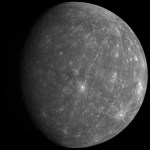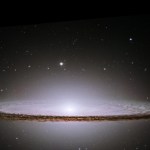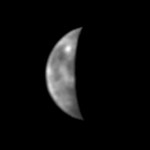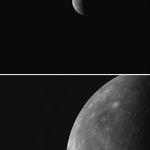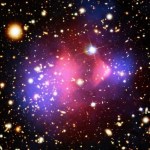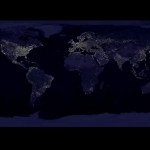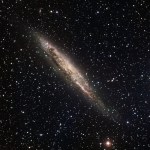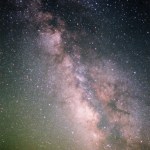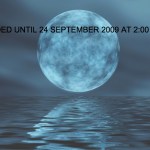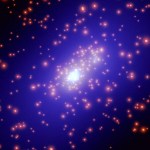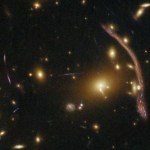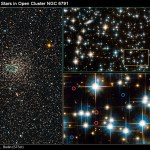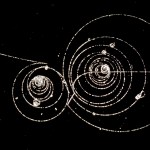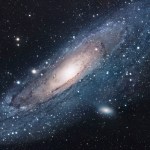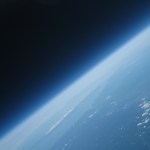
As you may have noticed, there's a new super-high resolution mosaic of the planet Mercury that's available.
How high resolution is it? Perhaps you should join me on my journey as I zoom in to the upper left hand corner. (Click each image to view it full-size.)
While Mercury may look unevenly cratered, keep in mind that there's a trick of the light going on here. When you're close to the limit of where the Sun's rays reach (the terminator), angles are lower and shadows are longer, making craters appear more pronounced.
In reality, there are "young" regions all over Mercury, where more…
You're sweet as a honey bee
But like a honey bee stings
You've gone and left my heart in pain
All you left is our favorite song
The one we danced to all night long
It used to bring sweet memories
Of a tender love that used to be
Now it's the same old song
But with a different meaning
Since you been gone --The Four Tops
Those of you who've been with me since the start of our current series on Dark Matter, including parts I, II, III, and 3.5, know that I'm a big proponent of dark matter. I think, based on everything that we know, that it is the simplest, easiest, and most likely explanation for…
Mercury, the closest planet to the Sun, never really has had a great picture taken of it. There are a number of reasons for this, such as:
It never gets more than 28 degrees away from the Sun, meaning we get two hours after sunset -- max -- to look at it.
Because the sky is still light, it's very hard to get a good resolution image from the ground.
Because of its proximity to the Sun, operators refuse to point space telescopes (like Hubble) towards Mercury, for fear of frying the telescope.
Mercury is far away and tiny, making for a disastrous photographic combination.
From Earth, this is…
Though my soul may set in darkness,
It will rise in perfect light,
I have loved the stars too fondly
To be fearful of the night. --Sarah Williams
Everyone knows how you see things during the day: sunlight makes it possible. Delivering huge amounts of visible light to the entire "day" side of the planet, everything becomes illuminated to human eyes.
But things change rapidly once the Sun goes down. Even with a full Moon in the sky (like last night), the amount of light reaching the Earth at night is over 100 trillion times less than during the day.
Still, we have a great pair of eyes, and…
Where else would you find a combination of Avenue Q and Sesame Street?
(Caution: adult themes in the very, very amusing video below.)
Because we all need something light once in a while. Hope you have a great weekend!
When I was a kid, Mercury and Pluto were the bookends of our Solar System. The two smallest planets, one of them was distant, icy, and raw, and the other was close in, speedy, and overcooked. One of them had the New Horizons mission planned for it, and the other had the Messenger mission.
Only one of them is still a planet, but Messenger just passed by Mercury for the third (and final) time. In early 2011, Messenger will settle into orbit around Mercury. Until then, you'll have to content yourself with these brand new images -- many just released today -- from Messenger's flyby of Mercury…
Many of you saw the pictures I posted Monday of colliding galaxy clusters. These pictures were spectacular, because they not only show galaxy clusters less than 200 million years after a collision (which is short, cosmically), they also show where the mass lies (traced in blue) and where the X-ray emitting areas are (pink). You get pictures like this one from the Bullet Cluster:
This one from MACS J0025:
And this one from Abell 520:
This is what happens when clusters collide, the normal matter gets separated from the dark matter! Let's tell you how.
Some normal matter is packed together in…
As many of you know, light pollution at night has become a big problem. It's a problem for flora and fauna, which rely on the "day/night" cycle that they've adapted to over billions of years, and it's a problem for astronomers, as the light pollution disrupts observations of the night sky. All over the world, light pollution is visible to anyone looking at the Earth, even from space.
But I've been watching a little bit of Isabella Rossellini's Green Porno, which is a series of entertaining, educational shorts about threatened species and the environmental consequences of eating them.
But…
Deep into the darkness peering,
long I stood there, wondering, fearing,
Doubting, dreaming dreams no mortal ever dared to dream before.
-Edgar Allen Poe, The Raven
Gazing out into the dark abyss of the night sky, stars, galaxies, and clusters shine like tiny islands of light against the blackness of deep space. Trillions upon trillions of protons and neutrons fuse together in stars across the Universe, producing all of this light, and decorating the sky above.
But, as we learned in part one of this series, the starlight that we see only accounts for 2% of all the matter that gravity tells us…
I've liked the musician Rufus Wainwright for some time, but I didn't realize that he was the son of Loudon Wainwright, whom I've just recently discovered. Loudon's a singer/songwriter who's been around for even longer, and who I like even better than Rufus. His song Father and Son was written for Rufus, but I think the Peter Blegvad song Daughter that he performs here is more appropriate for today.
Why? Because I just learned about the Asgarda women of the Ukraine, via Planet and Bust magazines.
[Image removed due to copyright claim.]
I take so many things for granted in this country that I…
The Milky Way is a mysterious swath of darkness and light through the night sky. In places where light pollution is low enough to see it, its beauty is unmistakable.
Well, the above image is what you might see with your naked eye. But even a small telescope can get you so much more. The darkest skies, with your naked eye, can provide you with the opportunity to see a few thousand stars.
But get yourself a small telescope? You're talking about tens of millions of stars, almost instantly. A small telescope, taking a large number of pictures and stitching them together, produced this image of a…
When I was first learning about the science of the Moon, there were a few basic facts that everyone got right. The Moon has practically no atmosphere, as when sunlight hits the Moon, it very quickly can give individual molecules and atoms enough energy to achieve escape velocity. We thought the same thing was true for any water on the Moon; sunlight would kick the water molecules so hard and so often that the molecules wouldn't remain on the Moon for very long, and therefore it would be completely dry.
A watery Moon? Possible at all? Well, there was one hope. You see, the Earth rotates on an…
Long you live and high you fly
Smiles you'll give and tears you'll cry
All you touch and all you see
Is all your life will ever be. -Pink Floyd
In part I of this series, we talked about a number of different ways -- all using gravity -- to measure the amount of matter in galaxies, clusters of galaxies, and the entire Universe. We got the same measurement no matter which method we used, finding out that 25-30% of the total energy of the Universe is in some type of matter. But, only about 0.5% of the total energy is in stars, which means that nearly all of this matter doesn't give off light! So…
Gravitational lensing happens when a cluster of galaxies happens to be directly between us and an even more distant galaxy. The light from these distant galaxies gets warped into arcs and, oftentimes, multiple images. This shot from the new Hubble camera shows exactly what I'm talking about:
Well, there are hundreds, if not thousands of these known galaxies stretched into multiple images. It's only a matter of time before we see one of these in a lensed galaxy:
Supernova! But what's amazing about this is that if we have multiple images, we'll only see the supernova go off in one of them!…
There are two ways to slide easily through life; to believe everything or to doubt everything. Both ways save us from thinking. -Alfred Korzybski
I've recently received a number of messages from readers of this site expressing doubts about the existence of dark matter. As someone who's researched dark matter extensively, it is my determination that dark matter most likely exists, although explaining exactly what it is is a challenge. Over this next series, I would like to lead you through the evidence, observations and discoveries that have led me to this conclusion, and I hope that I explain…
I've got to say, I get some weird things in my head sometimes. I don't know how many of you know who Vashti Bunyan is, but you may have heard a snippet from one of her songs last year in an NFL commercial. The beautiful, haunting song is called Train Song and it was the first song I thought of when I heard that Patrick Swayze died.
The song, of course, isn't about death at all. It's about traveling to meet someone you haven't seen in a long time and having your heart in your throat during the whole journey while you do it.
You might know Patrick Swayze best for Ghost, Dirty Dancing,…
Before you ask yourself, "what kind of incendiary title is that," let me put this in perspective. In 2001, I started graduate school at the University of Florida, and in 2002, I took one of the most difficult year-long courses a physics student can take: Quantum Field Theory. This was both the best and worst course I've ever taken. I worked harder for it than I ever have for any other course, I learned more for doing it than I had at any other time, it was the most difficult time I've ever had in a course, and it was superbly taught by one Richard Woodard. Quantum field theory is possibly the…
Andromeda, also known as M31, is the nearest large galaxy to us. At "only" 2 million light-years away, it gives us the best chance to study another spiral galaxy besides our own. I get particularly impressed by the high resolution images we can get, since it's so close to us. Andromeda looks like this in visible light:
And it looks like this in the ultra-violet:
But recently, a few very, very high-resolution pictures were taken, woven together to create a mosaic, and released to the public. The Ultraviolet light one -- made by the Swift satellite -- just came out today, but I thought I'd…
No, not you personally. But if you've ever thought about sending anything up into space, you may want to listen to this story about a couple of MIT students. For less than $150 in parts, with an amazing ease of assembly, they managed to send a device up to the brink of space, take some pictures, and recover the wreckage. At its apex, their entire apparatus reached an altitude of 93,000 feet (more than 28 km), sending it high into the stratosphere, high enough to take this picture:
Well, it isn't technically "space", but it is above more than 90% of the atmosphere and is certainly very, very…
Yesterday, I read something in international news that made me so mad I needed to share it with you:
That's right; my home country, the United States, will not distribute this film. There was no problem for the movie Expelled, a poorly argued anti-evolution flop that grossed just $7,598,071 despite appearing on more than 1,000 screens. And this new biopic, Creation, is much more about Darwin's life and personal struggles (which were real, by the way) than it is about evolution.
I have no information about the quality of this movie other than that reviews on the internet tell me it's pretty…
